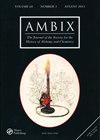The Contamination of the Earth. A History of Pollutions in the Industrial Age
IF 0.6
3区 哲学
Q3 HISTORY & PHILOSOPHY OF SCIENCE
引用次数: 0
Abstract
Jarrige and Le Roux’s book appeared in French in 2017; three years later MIT Press published a translation of this excellent work on the history of pollution. The book makes an important contribution to the fields of environmental history, social and economic history, the history of law and the state, histories of science and technology, and political ecology or ecological economics, among other eco-disciplines. It analyses pollution from the point of view of production and consumption, regulation, industrial lobbying, labour pressure, and devotion to economic growth all over the planet. Thus it presents a global history of pollution, divided chronologically into three parts from 1700 to the present day. The first part traces the emergence of industrial pollution between 1700 and 1830, from agrarian states and rural pollution to industrialisation and urban pollution. During this time there was a mandatory distance of more than twenty kilometres of gunpowder factories from cities, enforced by a public health police. But coal cities carried out what they called “the regulatory revolution” (p. 63). These changes in the protection, estimation, and compensation of industrial damage have been widely studied by historians. Jarrige and Le Roux, both experts on France, have managed to extend this story to all the industrial countries of the nineteenth century. The second part, “Naturalizing Pollutions in the Age of Progress (1830–1914),” shows that the pattern was global: instead of shutting down polluting factories, notions of progress required protecting them with new experts and new interpretations of the law. Chemistry became a “new frontier” (p. 106), organised and prepared to pollute without limits for the sake of progress. Thus were born the great chemical multinational corporations at the end of the nineteenth century, as well as new solvents, fertilisers, insecticides, and synthetic products. Legal and regulatory change up to the GreatWar was also global and always aimed at protecting the industry. This explains why public and neighbourhood protests were ubiquitous but unresolved, and not even the hygienists questioned the benefits of chemistry地球的污染。工业时代的污染史
Jarrige和Le Roux的书于2017年以法语出版;三年后,麻省理工学院出版社出版了这本关于污染史的优秀著作的译本。该书在环境史、社会经济史、法律与国家史、科学技术史、政治生态学或生态经济学等生态学科领域做出了重要贡献。它从生产和消费、监管、工业游说、劳动力压力和对全球经济增长的投入的角度分析污染。因此,它呈现了从1700年到今天的全球污染史,按时间顺序分为三个部分。第一部分追溯了1700年至1830年间工业污染的出现,从农业州和农村污染到工业化和城市污染。在此期间,公共卫生警察强制要求火药厂与城市保持20多公里的距离。但煤炭城市进行了他们所称的“监管革命”(第63页)。历史学家对工业损害的保护、估计和赔偿的这些变化进行了广泛的研究。Jarrige和Le Roux都是法国问题专家,他们成功地将这个故事推广到了19世纪的所有工业国家。第二部分“进步时代的污染自然化(1830-1914)”表明,这种模式是全球性的:进步的概念需要用新的专家和对法律的新解释来保护它们,而不是关闭污染工厂。化学成为一个“新的前沿”(第106页),为了进步,有组织地准备无限制地污染。于是,19世纪末诞生了伟大的化工跨国公司,以及新的溶剂、化肥、杀虫剂和合成产品。二战前的法律和监管变革也是全球性的,始终旨在保护该行业。这就解释了为什么公众和社区抗议无处不在,但没有得到解决,甚至卫生学家也没有质疑化学的好处
本文章由计算机程序翻译,如有差异,请以英文原文为准。
求助全文
约1分钟内获得全文
求助全文
来源期刊

Ambix
HISTORY & PHILOSOPHY OF SCIENCE-
CiteScore
0.80
自引率
60.00%
发文量
42
审稿时长
3 months
期刊介绍:
Ambix is an internationally recognised, peer-reviewed quarterly journal devoted to publishing high-quality, original research and book reviews in the intellectual, social and cultural history of alchemy and chemistry. It publishes studies, discussions, and primary sources relevant to the historical experience of all areas related to alchemy and chemistry covering all periods (ancient to modern) and geographical regions. Ambix publishes individual papers, focused thematic sections and larger special issues (either single or double and usually guest-edited). Topics covered by Ambix include, but are not limited to, interactions between alchemy and chemistry and other disciplines; chemical medicine and pharmacy; molecular sciences; practices allied to material, instrumental, institutional and visual cultures; environmental chemistry; the chemical industry; the appearance of alchemy and chemistry within popular culture; biographical and historiographical studies; and the study of issues related to gender, race, and colonial experience within the context of chemistry.
 求助内容:
求助内容: 应助结果提醒方式:
应助结果提醒方式:


